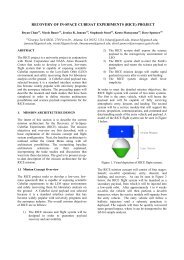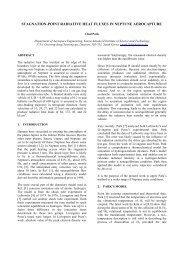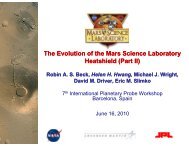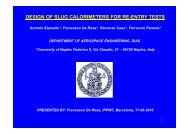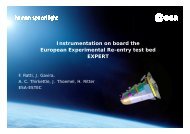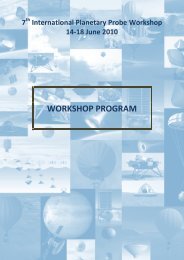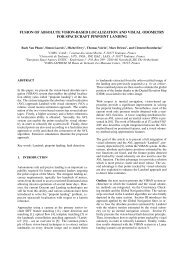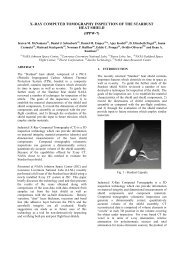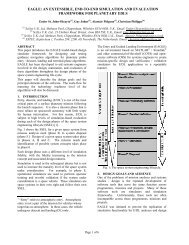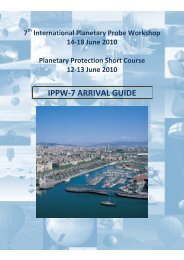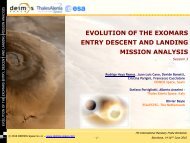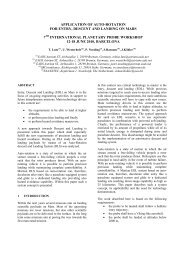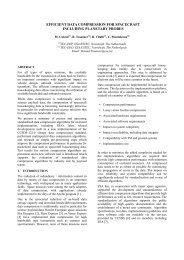Paper 342 - International Planetary Probe Workshop
Paper 342 - International Planetary Probe Workshop
Paper 342 - International Planetary Probe Workshop
You also want an ePaper? Increase the reach of your titles
YUMPU automatically turns print PDFs into web optimized ePapers that Google loves.
ACKNOWLEDGEMENTS<br />
Some of the research described in this paper was carried<br />
out at the Jet Propulsion Laboratory, California Institute<br />
of Technology, under a contract with the National<br />
Aeronautics and Space Administration.<br />
Johns Hopkins University/Applied Physics Laboratory,<br />
NASA Glenn Research Center, European Space<br />
Agency, and the French Space Agency CNES<br />
contributed to the research described in this paper.<br />
Fig. 15. CFD modeling of Titan montgolfière<br />
thermodynamics.<br />
6. SUMMARY AND CONCLUSIONS<br />
A broad range of studies assessing architecture options<br />
for the exploration of Titan have been performed over<br />
several decades by institutions including NASA, JPL,<br />
APL, ESA and CNES. While these studies have<br />
involved a variety of science definition teams with<br />
sometimes differing science objectives, a common<br />
element seen in all of these architectures is the<br />
recommendation of aerial and surface probes for in situ<br />
exploration. Partly as a result of these architectural<br />
findings, a significant amount of technology<br />
development has been completed toward reducing the<br />
implementation risks for such probes. This technology<br />
work has answered many initial questions, but<br />
significant additional risk reduction activities will be<br />
needed to ensure flight readiness.<br />
To prepare for the next mission to Titan, a risk<br />
reduction plan has been developed that responds<br />
directly to the major findings identified by NASA and<br />
ESA review boards in their review of the 2008 TSSM<br />
concept. This plan includes joint JPL and CNES efforts<br />
to mature the readiness of a Titan montgolfière probe, as<br />
well as efforts to demonstrate readiness of cryogenic in<br />
situ instruments and sampling systems. Completion of<br />
these activities is key to enabling future multi-probe in<br />
situ missions to Titan.<br />
REFERENCES<br />
[1] TSSM Final Report on the NASA Contribution to a<br />
Joint Mission with ESA, 3 November 2008, JPL D-<br />
48148, NASA Task Order NMO710851.<br />
[2] TSSM NASA/ESA Joint Summary Report, 15<br />
November 2008, ESA-SRE(2008)3, JPL D-48442,<br />
NASA Task Order NMO710851.<br />
Special acknowledgement goes to Dennis Matson,<br />
Candice Hansen, John Elliott, Nathan Strange, David<br />
Mohr, Melissa Jones, Pat Beauchamp, Christophe Sotin,<br />
Tom Spilker, Sarah Hornbeck (Jet Propulsion<br />
Laboratory); Jonathan Lunine (University of Arizona);<br />
Athena Coustenis (Observatoire de Paris-Meudon,<br />
France); Jean-Pierre Lebreton and Christian Erd (ESA-<br />
ESTEC); Andre Vargas (CNES); and the entire<br />
US/European JSDT for their extensive contributions to<br />
this material.<br />
BIOGRAPHY<br />
Kim R. Reh has a<br />
broad base of<br />
program, project, and<br />
line organization<br />
experience that spans<br />
project formulation<br />
through<br />
implementation. His<br />
experience includes significant interaction with the<br />
science community, working with international partners<br />
and implementing projects according to NASA<br />
requirements for management of flight projects.<br />
Kim is currently the Deputy Program Manager for JPL’s<br />
Solar System Exploration Mission Formulation Office.<br />
He is also the Lead for Titan mission formulation and<br />
risk reduction activities.<br />
Kim received his BSE from the University of Michigan,<br />
MSE from California State Polytechnic University,<br />
Business Management Certificate from the University<br />
of California Riverside, and Certificate of Executive<br />
Management at Caltech. Additionally, Kim has taken<br />
many continuing education courses in technical and<br />
management fields.<br />
John Elliott is a senior engineer in JPL’s<br />
Lunar and <strong>Planetary</strong> Mission Concepts<br />
group. He is currently leading studies in<br />
support of the NRC Decadal Survey in<br />
addition to ongoing work in the<br />
development of concepts for robotic<br />
Copyright 2010. All rights reserved<br />
10



